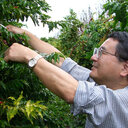Accumulation and function of trigonelline in non-leguminous plants.
关键词
抽象
As part of our studies of the occurrence, biosynthesis, function and human use of trigonelline, we looked at trigonelline-accumulating plant species and at the distribution of trigonelline in different organs of trigonelline-accumulating non-leguminous plants. There are many trigonelline-synthesizing plant species, but apart from legume seeds only a few species accumulate high concentrations of trigonelline. We have found only three species that accumulate high levels of trigonelline: Murraya paniculata (orange jessamine), Coffea arabica (coffee) and Mirabilisjalapa (four o'clock flower). Trigonelline was found in all parts of Murraya paniculata seedlings at 4-13 micromol/g fresh weight; more than 70% was distributed in the leaves. In the coffee plant, trigonelline was found in all organs, and the concentrations in the upper stems, including tips (48 micromol/g FW) and seeds (26 micromol/g FW), were higher than in other organs. In Mirabilis jalapa plants, trigonelline was found in leaves, stems, flowers, roots and seeds; the concentration varied from 0.3 to 13 micromol/g FW and was generally higher in young tissues than in mature tissues, except for seeds. Exogenously supplied nicotinamide increases the trigonelline content. The in planta role of trigonelline and the possible use oftrigonelline-accumulating plants in herbal medicine are discussed.



